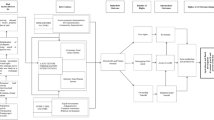Abstract
We study the non-renewals of contracts in the farmland differential assessment program of California. An instrumental variable random-effect model for the location of non-renewals and a hazard model for the timing of non-renewals indicate that counties with high property tax rates have 0.8% lower odds of a non-renewal, transition slower to a rapid state of non-renewals by 4%, and transition faster to the slow state by 6%. This suggests differential assessment programs provide benefits to tax payers by preserving agricultural land and reducing how quickly development pressure causes non-renewals, and ultimately development, in farm communities. Counties at higher elevations transition faster to a rapid state of non-renewals by 4% and transition slower to the slow state by 2%. This suggests there should be more attention to development pressure at higher elevations, where regulations are weaker and amenities are greater.
Similar content being viewed by others
References
Baltagi BH (1981) Simultaneous equations with error components. J Econom 17: 189–200
Blewett RA, Lane JI (1988) Development rights and the differential assessment of agricultural land: fractional valuation of farmland is ineffective for preserving open space and subsidizes speculation. Am J Econ Sociol 47(2): 195–205
Cameron C, Trivedi P (2005) Microeconometrics: methods and applications. Cambridge University Press, New York, pp 573–664
Capozza DR, Helsley RW (1990) The stochastic city. J Urban Econ 28: 187–203
Capozza DR, Li Y (1994) The intensity and timing of investment: the case of land. Am Econ Rev 84(4): 889–904
Capozza DR, Li Y (2002) Optimal land development decisions. J Urban Econ 51: 123–142
Grenadier S (2002) Option exercise games: an application to the equilibrium investment strategies of firms. Rev Financ Stud 15(3): 691–721
Hite D, Sohngen B, Templeton J (2003) Zoning, development timing, and agricultural land use at the suburban fringe: a competing risks approach. Agric Resour Econ Rev 32(1): 145–157
Irwin EG, Bockstael NE (2002) Interacting agents, spatial externalities, and the evolution of residential land use patterns. J Econ Geogr 2(1): 31–54
Kline J, Wichelns D (1994) Using referendum data to characterize public support for purchasing development rights to farmland. Land Econ 70(2): 223–233
Larson JM, Findeis JL, Smith SM (2001) Agricultural adaptation to urbanization in Southeastern Pennsylvania. Agr Resource Econ Rev 30(1):32–43
Rosenberger RS, Sperow M, English DB (2008) Economies in transition and public land-use policy: discrete duration model of Eastern wilderness designation. Land Econ 84(2): 267–281
Therneau TM, Grambsch P (2001) Modeling survival data: extending the Cox model, statistics for biology and health series. Springer, New York
Towe CA, Nickerson C, Bockstael N (2008) An empirical examination of the timing and conversions in the presence of farmland preservation programs. Am J Agric Econ 90(3): 613–626
U.S. Department of Agriculture, National Agricultural Statistics Service (2008) California Agricultural Statistics 2007 Crop Year. California Field Office, October
Wu JJ, Cho S (2007) The effect of local land use regulations on urban development in the Western United States. Reg Sci Urban Econ 37(1): 69–86
Author information
Authors and Affiliations
Corresponding author
Rights and permissions
About this article
Cite this article
Kovacs, K. An empirical examination of the location and timing of non-renewals in a farmland differential assessment program. Ann Reg Sci 50, 245–263 (2013). https://doi.org/10.1007/s00168-011-0474-0
Received:
Accepted:
Published:
Issue Date:
DOI: https://doi.org/10.1007/s00168-011-0474-0




